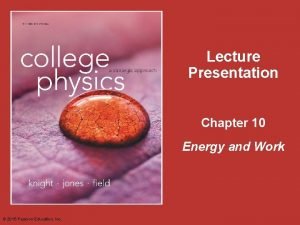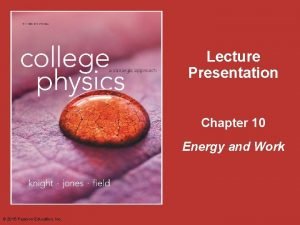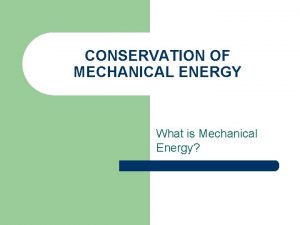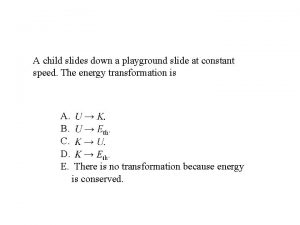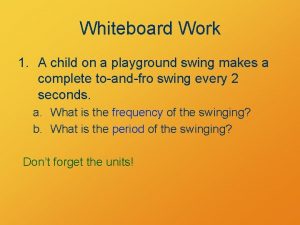Chapter 11 A child slides down a playground




















- Slides: 20

Chapter 11

A child slides down a playground slide at constant speed. The energy transformation is 5. There is no transformation because energy is conserved.

A child slides down a playground slide at constant speed. The energy transformation is 5. There is no transformation because energy is conserved.

A particle moving along the x-axis experiences the force shown in the graph. If the particle has 2. 0 J of kinetic energy as it passes x = 0 m, what is its kinetic energy when it reaches x = 4 m? 1. – 2. 0 J 2. 0. 0 J 3. 2. 0 J 4. 4. 0 J 5. 6. 0 J

A particle moving along the x-axis experiences the force shown in the graph. If the particle has 2. 0 J of kinetic energy as it passes x = 0 m, what is its kinetic energy when it reaches x = 4 m? 1. – 2. 0 J 2. 0. 0 J 3. 2. 0 J 4. 4. 0 J 5. 6. 0 J

A crane lowers a steel girder into place at a construction site. The girder moves with constant speed. Consider the work Wg done by gravity and the work WT done by the tension in the cable. Which of the following is correct? 1. 2. 3. 4. 5. Wg is positive and WT is positive. Wg is negative and WT is negative. Wg is positive and WT is negative. Wg and WT are both zero. Wg is negative and WT is positive.

A crane lowers a steel girder into place at a construction site. The girder moves with constant speed. Consider the work Wg done by gravity and the work WT done by the tension in the cable. Which of the following is correct? 1. 2. 3. 4. 5. Wg is positive and WT is positive. Wg is negative and WT is negative. Wg is positive and WT is negative. Wg and WT are both zero. Wg is negative and WT is positive.

Which force does the most work? 1. The 6 N force. 2. The 8 N force. 3. The 10 N force. 4. They all do the same amount of work.

Which force does the most work? 1. The 6 N force. 2. The 8 N force. 3. The 10 N force. 4. They all do the same amount of work.

A particle moves along the x-axis with the potential energy shown. The force on the particle when it is at x = 4 m is 1. 4 N. 2. 2 N. 3. 1 N. 4. – 1 N. 5. – 2 N.

A particle moves along the x-axis with the potential energy shown. The force on the particle when it is at x = 4 m is 1. 4 N. 2. 2 N. 3. 1 N. 4. – 1 N. 5. – 2 N.

A child at the playground slides down a pole at constant speed. This is a situation in which 1. 2. 3. 4. 5. U ® Eth. Emech is conserved. U ® K. Emech is not conserved but Esys is. K ® Eth. Emech is not conserved but Esys is. U ® Wext. Neither Emech nor Esys are conserved.

A child at the playground slides down a pole at constant speed. This is a situation in which 1. 2. 3. 4. 5. U ® Eth. Emech is conserved. U ® K. Emech is not conserved but Esys is. K ® Eth. Emech is not conserved but Esys is. U ® Wext. Neither Emech nor Esys are conserved.

Four students run up the stairs in the time shown. Rank in order, from largest to smallest, their power outputs Pa to Pd. 1. 2. 3. 4. 5. Pb > Pa = Pc > Pd Pd > Pa = Pb > Pc Pd > Pb > Pa > Pc > Pd Pc > Pb = Pa > Pd

Four students run up the stairs in the time shown. Rank in order, from largest to smallest, their power outputs Pa to Pd. 1. 2. 3. 4. 5. Pb > Pa = Pc > Pd Pd > Pa = Pb > Pc Pd > Pb > Pa > Pc > Pd Pc > Pb = Pa > Pd

Chapter 11 Reading Quiz

The statement ∆K = W is called the 1. law of conservation of energy. 2. work-kinetic energy theorem. 3. kinetic energy equation. 4. weight-kinetic energy theorem.

The statement ∆K = W is called the 1. law of conservation of energy. 2. work-kinetic energy theorem. 3. kinetic energy equation. 4. weight-kinetic energy theorem.

The transfer of energy to a system by the application of a force is called 1. Dot product. 2. Power. 3. Work. 4. Watt. 5. Energy transformations.

The transfer of energy to a system by the application of a force is called 1. Dot product. 2. Power. 3. Work. 4. Watt. 5. Energy transformations.
 A small child slides down the four frictionless slides
A small child slides down the four frictionless slides Final energy quick check
Final energy quick check Identifying qualitative graphs answer key
Identifying qualitative graphs answer key A child is on a playground swing motionless
A child is on a playground swing motionless A child is on a playground swing motionless
A child is on a playground swing motionless 이진트리 복사 순회
이진트리 복사 순회 Work-energy theorem
Work-energy theorem How is mechanical energy conserved?
How is mechanical energy conserved? A 23 kg child goes down a straight slide
A 23 kg child goes down a straight slide Learning profile down syndrome
Learning profile down syndrome King jesus you're the name
King jesus you're the name Hands on hips text
Hands on hips text There's a place where streams of grace
There's a place where streams of grace Pushing down on me pushing down on you
Pushing down on me pushing down on you I fled him
I fled him Google machine learning playground
Google machine learning playground Playground.tensorflow
Playground.tensorflow Yandex image search
Yandex image search Neural net playground
Neural net playground What bnf stands for
What bnf stands for The world overflowing like a treasure chest
The world overflowing like a treasure chest



